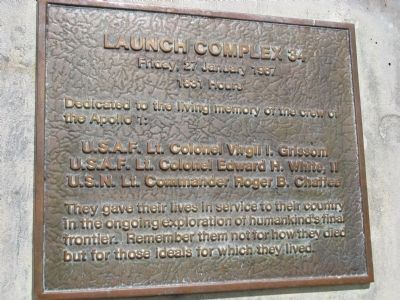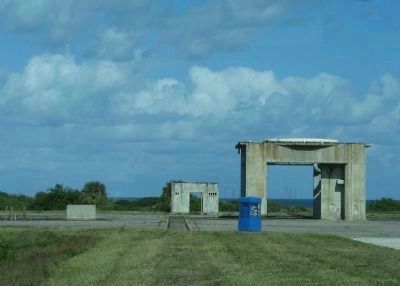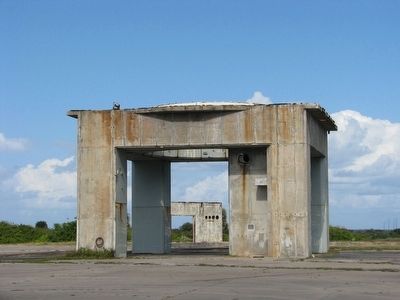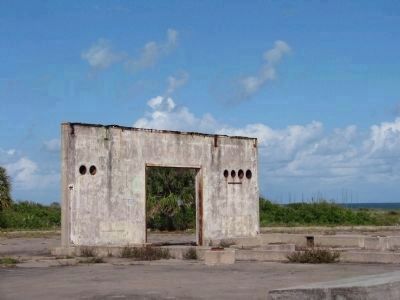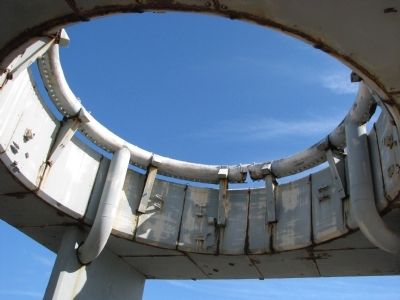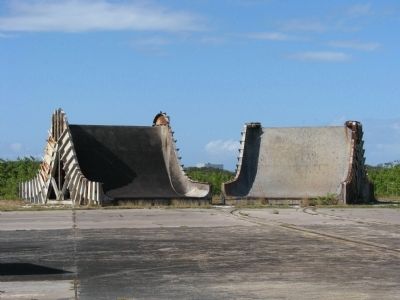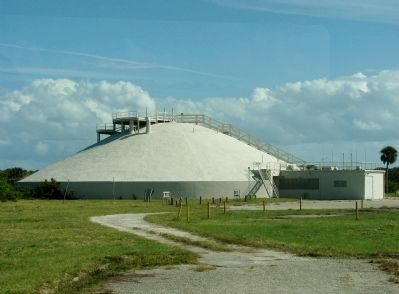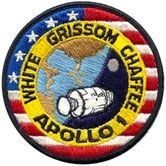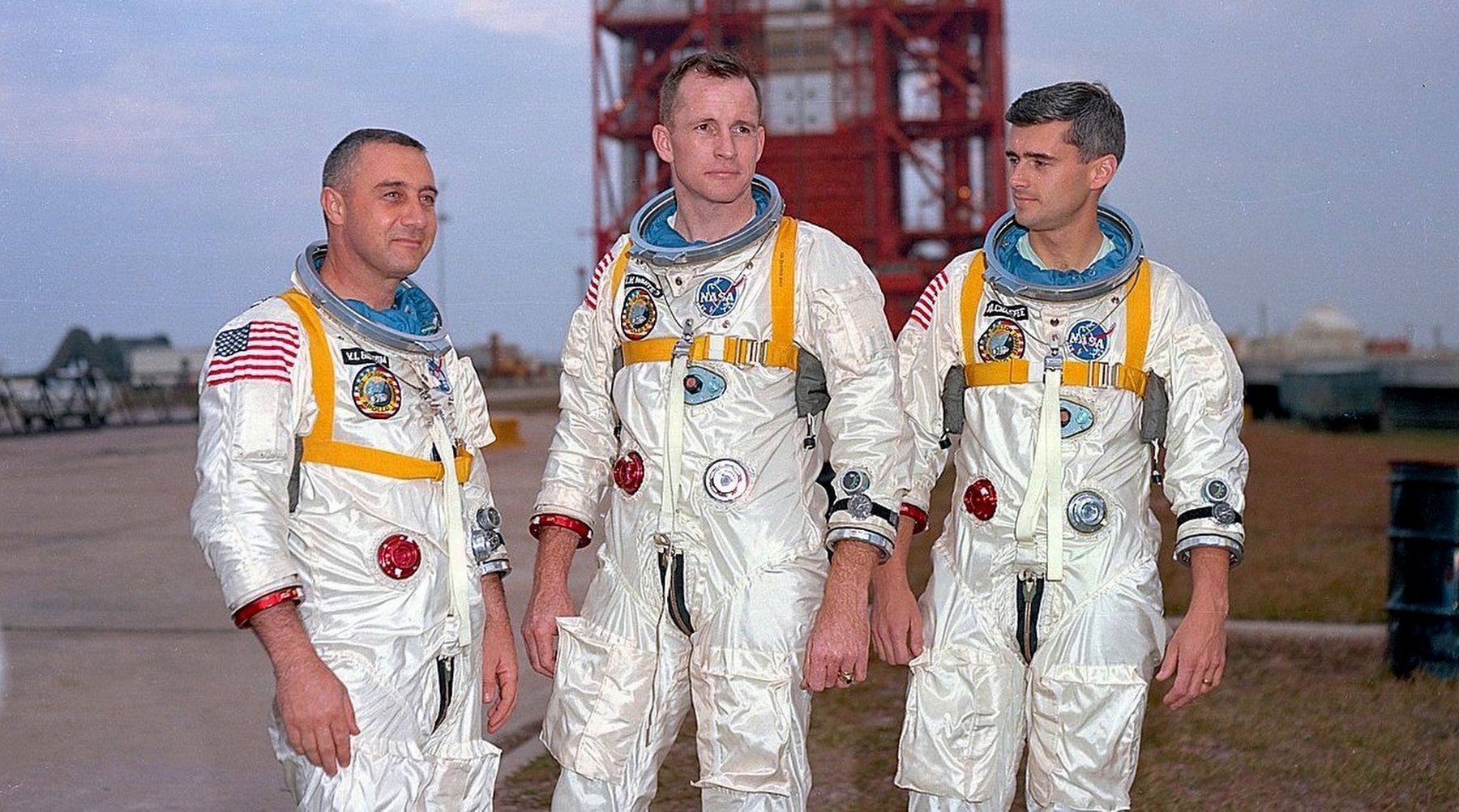Cape Canaveral in Brevard County, Florida — The American South (South Atlantic)
Launch Complex 34
Friday, 27 January 1967
— 1831 Hours —
Dedicated to the living memory of the crew of the Apollo 1:
U.S.A.F Lt. Colonel Virgil I. Grissom
U.S.A.F. Lt. Colonel Edward H. White, II
U.S.N. Lt. Commander Roger B. Chaffee
They gave their lives in service to their country in the ongoing exploration of humankind’s final frontier. Remember them not for how they died but for those ideals for which they lived.
Topics. This historical marker is listed in these topic lists: Air & Space • Disasters • Exploration.
Location. 28° 31.307′ N, 80° 33.664′ W. Marker is in Cape Canaveral, Florida, in Brevard County. The marker is mounted on the Apollo I Launch Pedestal remains at historic Launch Complex 34, Kennedy Space Center, Florida. Touch for map. Marker is in this post office area: Cape Canaveral FL 32920, United States of America. Touch for directions.
Other nearby markers. At least 8 other markers are within 6 miles of this marker, measured as the crow flies. Complex 14 (approx. 2.2 miles away); Mission (Mercury) Control Center (approx. 4.3 miles away); Cape Canaveral's Native Americans (approx. 4.4 miles away); Cape Canaveral Lighthouse (approx. 4.4 miles away); Early Cape Life (approx. 4.4 miles away); Cape Canaveral Light Station (approx. 4.4 miles away); a different marker also named Cape Canaveral Lighthouse (approx. 4.4 miles away); Launch Site of America's First Satellite, Explorer I / The Space Race Begins (approx. 5.4 miles away). Touch for a list and map of all markers in Cape Canaveral.
Regarding Launch Complex 34.
The first launch site to be built for the express purpose of the peaceful exploration of space, Launch Complex 34 required three years from initial concept in September 1958 to her first launch in October 1961.
Although all that remains of her primary features are the launch pad, launch pedestal, blockhouse, a few small walls, and the huge flame deflectors, the spirit of Apollo is alive and vibrant and is located at Launch Complex 34.
The Apollo I Launch Pedestal and Launch Complex 34 have been preserved as a permanent memorial for the three astronauts who perished in the January 27, 1967 fire.
Also see . . .
1. Complex 34.
On January 27, 1967, a simulated flight was to be performed with the Apollo 204 vehicle, which should have later been launched as Apollo 1. This test, known as an "Overall Test Plugs Out", simulated an actual flight as closely as possible. A countdown would be conducted, all communication and
instrumentation systems would be activated, and the umbilical that connected the space vehicle to the launch pad would be disconnected.
The launch vehicle was in place on the launch pad at Complex 34. In the capsule were Virgil I. "Gus" Grissom, Edward H. White II, and Roger B. Chaffee. Having entered the capsule after one o'clock P.M., the three were still there at 6:30 P.M. with the countdown stalled at T-10 minutes (communications problems had plagued the test all day). Shortly after 6:30 P.M., disaster struck. A small electrical fire, fed by nylon netting and the 16.2 p.s.i. of pure oxygen in the cabin, reached a blaze. Less than a minute after the initial report of a fire in the capsule, the crew of Apollo 1 was dead. (Submitted on April 8, 2014, by Cosmos Mariner of Cape Canaveral, Florida.)
2. Complex 34 launch pedestal.
The most prominent feature of the remains of Complex 34 is the launch pedestal. Made of concrete and steel, it stands 27 feet tall, and is 42 feet long on each side. As seen in the picture above, the top of the pedestal is open to the sky. On the left leg are stenciled the words "ABANDON IN PLACE." On the right leg (and in another location on the structure) are two plaques in memorial to the crew of Apollo 1. Through the legs of the structure, you can see two blast deflectors. (Submitted on April 8, 2014, by Cosmos Mariner of Cape Canaveral, Florida.)
Credits. This page was last revised on February 22, 2022. It was originally submitted on April 8, 2014, by Cosmos Mariner of Cape Canaveral, Florida. This page has been viewed 660 times since then and 18 times this year. Photos: 1, 2, 3, 4, 5, 6, 7. submitted on April 8, 2014, by Cosmos Mariner of Cape Canaveral, Florida. 8, 9. submitted on September 9, 2020, by Larry Gertner of New York, New York. • Bernard Fisher was the editor who published this page.
